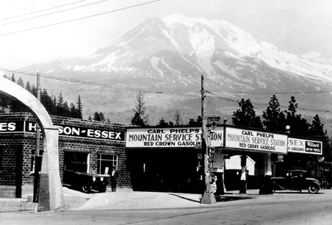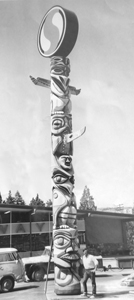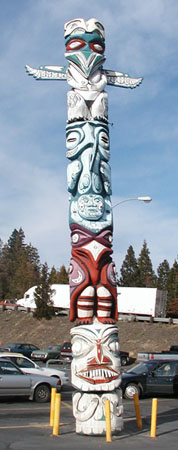
Questions?
Email us at: JandK@LivingGoldPress.com
 HOME
HOME
 |
Email us at: JandK@LivingGoldPress.com
|
The Weed, CA Totem Pole - What's It All About?© Jill Livingston 2019 (A version of this article originally appeared in the Friends of the Siskiyou County Museum Newsletter, Winter 2019-2020) |
 The original small totem pole in front of the Mountain Service Station (obscured by power pole) |
  Weed totem, then (1962) and now. |
 An ad for Alaskan Campers, frequently seen on the Alaskan Highway starting in the 1950s. |
|
The town of Weed and its totem pole have a history that goes back almost 100 years. But the first question to be answered is “Why here?” The totem pole in the Ray’s Supermarket parking lot sits at the southern terminus of US Highway 97, but it is a fallacy to say that 97 is “the start of the Alaska Highway.” True, this road is the most direct connection to reach it from northern California, but the actual Alaska Highway began in Dawson Creek, British Columbia, around 1600 miles north of Weed. This is the highway that the US Army Corps of Engineers, with 10,000 workers, raced to build in 1942, as Alaska was vital to our defense against Japan. (Ironically, the vast majority of war supplies ended up being transported to Alaska by ship.) After the war most of the road was still unpaved and driving it became a proving ground for hardy road warriors driving ¾ ton pickups topped with aluminum Alaskan Campers.Another irony is that nowhere along the real Alaska Highway or US97 did native people reside who actually carved totem poles; they were creations of coastal peoples and the entire Alaska Highway/US 97 route runs inland. Nevertheless, totem poles have come to symbolize Alaska, but the fact that Weed, with its windy often wintery climate, sometimes “feels like” Alaska has nothing to do with why a totem pole is here. The first totem pole in Weed, as seen in postcards from the era, was erected in front of Carl Phelps’ Mountain Service Station in 1922. This was located next to the original concrete Weed arch on the SE corner of Weed Blvd. and Main St., the US99/US97 junction at that time. Phelps had come to Weed from Seattle, and Seattle had a definite connection to Alaska, being a port with ready access to “Seward’s Icebox” and the jumping off spot for Yukon gold rush prospectors. Around the turn of the century the totem poles seen in coastal villages were recognized as works of art, but with shocking arrogance they were routinely filched from the villages and shipped back to be sold to museums and collectors or erected in public places. The small totem pole at the gas station had come from Seattle and was said to be authentic so it seems likely that it was one of these. So Phelps started the tradition but at some point the first pole was removed, possibly when the road was widened or the gas station enlarged. By the 1960s it was in private hands, purchased at a rummage sale. Meanwhile, in 1962 Safeway moved off of Main Street into a new building at the new US97 junction and management took the opportunity to commission a new totem pole, the one that is still in place. Barney West from Redding was the artist chosen to carve a larger-sized replica of the earlier pole from a 32 foot section of redwood cut in the Santa Cruz mountains. It took him three months to carve, sand and paint the pillar, and in the end it was topped with a lighted, rotating “S.” The “S” has been gone for some time now, as the grocery store became a Gil’s, and now a Ray’s Supermarket. The Weed totem pole stands in a pretty harsh climate but the town, which truly appreciates this landmark, has seen to needed refurbishings a time or two. |